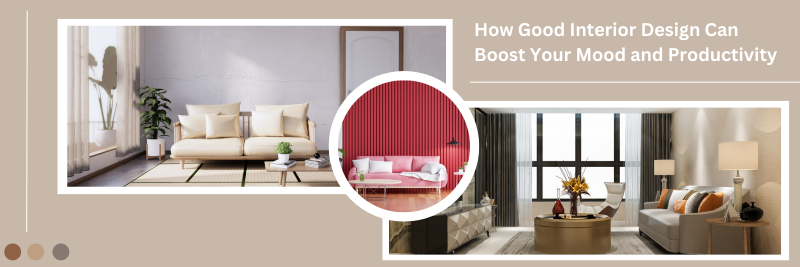Home design transcends the mere aesthetics and style; its influence on one’s living condition can’t be over-emphasized-it has a great hold on the well-being of being in that space. A living room, an office, a kitchen-it’s all about the environment you’re in, and it tends to affect your mood, energy levels, and even productivity. From colour scheme to furniture, all the little things go into painting the overall atmosphere, which should help your well-being. Understand the potential of good interior design in uplifting moods and enhancing productivity and learn how to transform your space into an effective and positive environment.
1. The Psychology of Color
Colour : While colour is one of the most effective tools that interior designers use, different colours can affect your mood. For example, bright or beautiful colours are great for places where you are going to think or relax.
- Blue: This colour is often used to represent the calm condition and heals stress and anxiety. It perfectly deals with bedrooms and other places of study focusing on comfort and calmness.
- Yellow: fosters feelings of happiness, energy, and optimism. These areas of the house, such as the kitchen or home office, should be painted in yellow to promote creativity and motivation.
- Green: Green reminds of balance and harmony. It does not exert as much strain on one’s eyes, although it would still be all right for offices or workspaces that require sustained attention and focus.
- Red: Red is energetic and stimulating. Too large an amount is overwhelming, though, but very efficient in the living room or gym, where even more physical activity or interaction is spurred.
- Neutrals: Whites, greys, and beige are neutral colours that may be built upon to add the illusion of spaciousness. These may be scattered all over a house for serenity and simplicity by being a backdrop for more energetic accent colours.
However, when these are used with foresight, you can have a space that can well support your requirements even while uplifting your moods.
2. The Strength of Natural Light
Natural light is probably one of the most important elements of interior designs and, without a doubt, really well stated regarding the impact it produces on moods and productivity. Natural light has the effect of increasing serotonin levels in the brain; this helps in making someone feel energised and focused. Moreover, exposure to natural light regulates one’s circadian rhythm, contributing to better sleeping habits.
Make the most of natural light in your room through clever window positioning, light-coloured walls and reflective surfaces, and sheer curtains or blinds that allow light to flood into the room. Sit by a window in any workspace to dramatically improve your productivity and your mood.
Light fixtures that mimic daylight should be used in enclosed areas. In any case, mirrors should reflect light to the different parts of rooms, making it appear roomy and open.
3. Furniture layout and functionality
A layout can also affect your usage of the space while at the same time affecting your mood. Properly put furniture in a room can easily make one get the feeling of distress and disorganisation when the place is shown all over in a mess, while planning properly makes one feel relaxed and focused.
Here’s how the right layout can boost productivity:
- Open, clutter-free spaces: An open space offers easier flow and freedom in the room. A clutter-free surface makes for a home office’s desk. Note how this general message of “clean space” can make your focus cut the distraction.
- Defined zones. In larger spaces, such as in a living room or open-plan homes, it can be defined with smaller zones for different activities that will help in keeping a place organised and maintain productivity, such as reading nook, television viewing area, and work zone-all transitioning into one task without feeling overwhelmed.
- Comfortable Seating: Comfortable furniture fosters productivity through the promotion of proper posture and negation of discomfort. For example, an office is devoid of back pain resulting from back strain due to improper sitting postures on the seats and desks. Similarly, comfortable seating in a living room or bedroom promotes relaxation and the feeling of warmth.
ABM Furniture: well designed. Modular furniture which is able to help meet your needs as far as space is concerned, which therefore, can easily be designed to make it suitable for any functional and stylish format.
4. Personalized Spaces
When your space reflects who you are, it helps to boost your mood by giving you a feeling of comfort and being at ease in your surroundings. Personalised design choice, in the form of artwork, family photographs, or meaningful objects, all of them evoke those positive feelings by creating a sense of ownership and being at comfort within the same space.
Here is why personalization matters:
- Identity and Comfort: one’s space represents who he or she is, it is quite easy to both relax and forget any problem outside. An office at home with personal elements such as framed artwork or a favourite plant makes the workplace more welcoming rather than being clinical.
- Motivational Elements: Inspirational quotes, art, or decorations that are aligned with your values will keep a negative mindset from lingering and motivate you to continue performing.
While personalization is the key, finding a balance is also very important because overstuffing a space with too many personal items or distractions can easily lead to clutter that may spur the negative effect on productivity.
5. Texture and Materials
The materials used for furniture and other decorations could also influence the mood or atmosphere in a room. Soft, luxurious materials, such as velvet or linen, make us feel relaxed. Meanwhile, sleek and smooth materials make an atmosphere feel more modern and professional for glass and metal.
How different textures influence your mood and productivity
- Soft textures make a room inviting and cozy when applied in your bedroom, living room, or office. Richly upholstered furniture and plush carpets add a lot of warmth to a room; delicate fabrics can even create serenity.
- Natural elements: Wood, stone, and wool can invoke a sense of peace and tranquillity by bringing people back to their surroundings. Studies have it that natural elements reduce stress and ensure a better life. A wooden frame desk or a fireplace can bring a peaceful earthly feature into a room.
- High Quality Finishes: Furniture and decor finish will impact the aesthetic and function of a space. High-quality materials such as hardwood or premium leather not only look classy but also last longer and thus provide a sense of stability and trustworthiness.
Pay attention to tactile experiences in the space as they can often influence mood throughout the day.
6. Plants and Greenery
Plants give your interior many aesthetic and psychological benefits. They make your indoor space look alive, yet at the same time purify the environment and reduce toxins to make it healthier and more lively. In fact, researchers have also discovered that people who have plants in their environments tend to lower their stress and be more focused, for the most part leading to a positive sense of well-being.
- Plants that are low on the care list, such as succulents and peace lilies, will be perfect for your office space, while bigger plants like fiddle-leaf figs or snake plants will successfully create a soothing, natural atmosphere in living rooms or bedrooms.
- Benefits for Productivity: There have already been researches that show just the mere presence of plants promotes concentration and raises productivity due to the reduction of mental fatigue and improvement in cognitive function. Greenery seems to add a refreshing energy in the workplace, keeping you more engrossed and focused during long hours at work.
7. Creating a Calming Atmosphere with Lighting
Lighting forms the most salient part of interior design. It not only bears a relation of sorts to how you are likely to feel in any particular room, but it also impacts your circadian rhythm-the regulation of your internal clock, that is to say, the circadian rhythm-as well as your general well-being. Proper lighting cuts eye strain, minimises distraction, and allows you to focus better.
- Task Lighting: Concentrated lighting, such as a desk lamp or reading light, is designed for focused tasks that must be done at a specific point of concentration. Appropriate task lighting also prevents eye strain and keeps work or reading focused.
- Ambient Lighting Ambient lights, overhead lights, and floor lamps all can be set in a soft, even manner that creates a very relaxing ambiance. Adjustable lighting that can allow you to transition the mood of the room will easily transition you from work mode to relaxation mode.
- Accent lighting: In the case of accent lighting, it would really highlight specific features of the house you own, like an art piece or architectural details. It can also bring a cozy feel to it in a space of the bedroom or the living room.
When you design your space bring in multiple sources of light and layer it so that it is functionally, but mood-wise as well.
8. Wellness in Home Design
Well, one of the new trends in interior design is wellness. More and more people look to create spaces that offer physical and mental health. Contributing to a healthier, more productive environment are air purifiers, water features, and ergonomic furniture.
- Ergonomic Furniture. Ergonomic furniture, including adjustable desks and chairs, supports good posture, helps reduce strain and increases one’s focus. It is especially important in home offices, as you may spend long hours working.
- Air Quality: This can have an influence on your health and well-being depending upon how clean the air is inside your house. You can purchase an air purifier or other plants that purify the air inside your home naturally.
- Water Features: A water feature such as a small, indoor fountain will calm your mind and body. It has long been proven to improve focus while also helping to encourage relaxation due to the pure sound of running water.
Conclusion
Proper interior design does more than make your house or working space look nice-it impacts how you feel and work. Understanding how colour, layout, lighting, texture, and personal elements shape the psychological impact on space, you can develop a stimulating environment that boosts your mood, relaxing tendencies, or lifts your performance.
Whether it’s an office, a reception room, or a kitchen, interior design plays a significant role in how you feel in a space. Get hold of experts such as ABM Furniture and their customised furniture solutions to help create spaces tailored to your needs. Be it furniture selection or sales, Indore’s best furniture showroom in Indore offers genuine advice and inspiration to help you make your space truly yours.



